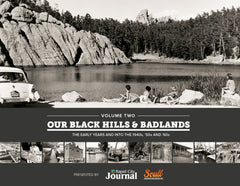Tootsie, South Dakota's Singing Coyote
From the late 1940s through the 1950s, an abandoned coyote pup sang her way into the hearts of South Dakota residents.

“Coyote” Fred Borsch and Tootsie the Singing Coyote with the Spot Liquor Store wagon, Deadwood, 1953. Tootsie was dubbed South Dakota’s State Animal by Gov. George Mickelson in 1949.
Courtesy Deadwood History, Inc.
Before making her mark as South Dakota's state animal, Tootsie was a star in Deadwood's annual Days of 76 Parade with her singing partner, Fred Borsch.
Tootsie was found by Ollie Wiswell in Custer Peak and came to live with Borsch and his wife, Esther, in 1947.
Borsch taught Tootsie to sing by having her howls follow the changing pitch in his own voice. Her singing drew a lot of attention and she was soon recording her songs, touring around the state and making personal appearances.

“Coyote” Fred Borsch and Tootsie the Singing Coyote promoting the new Western Air Lines Spearfish-Rapid City route, 1958.
Courtesy Deadwood History, Inc.
When she wasn't performing, Tootsie could often be found at Borsch's liquor store in Deadwood and was sometimes dressed up in a fancy collar for special occasions like the Days of 76 Parade.
Find more stunning and historic images of the Black Hills and Badlands in Rapid City Journal's new pictorial history book, Our Black Hills & Badlands Vol. II: The Early Years and Into The 1940s, '50s and '60s.

$44.95